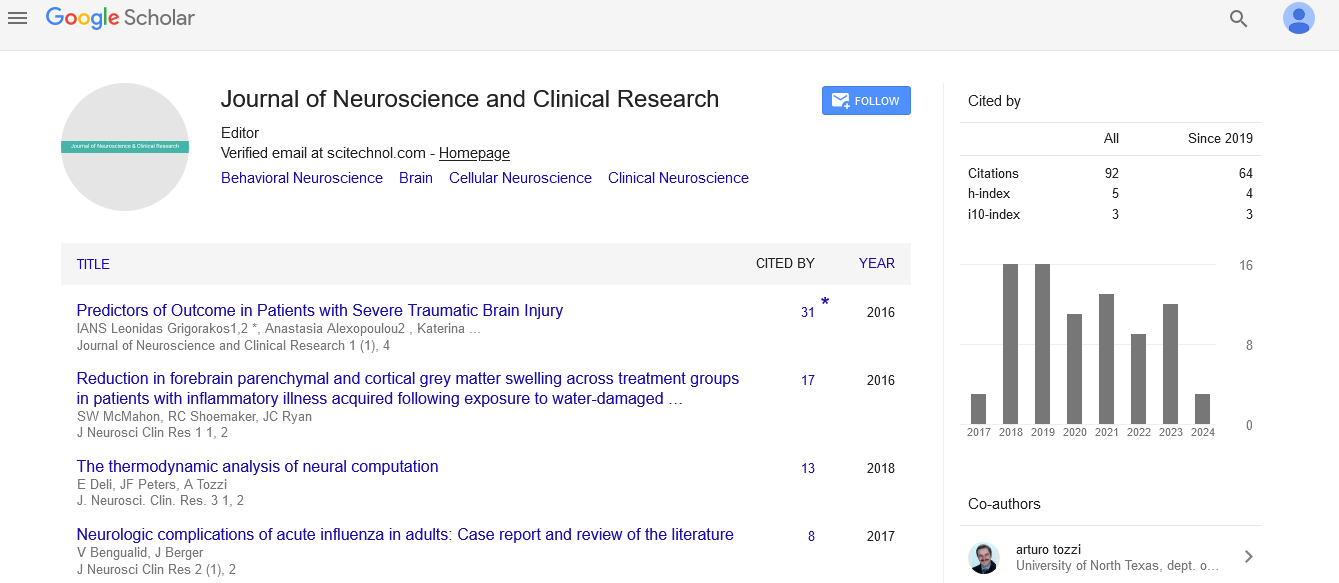Commentary, J Neurosci Clin Res Vol: 9 Issue: 2
The Brain's Role in Sensory Perception: Connecting the Dots
Minlyu Huiaqng*
1Department of Neurology, Qingdao University, Qingdao, China
*Corresponding Author: Minlyu Huiaqng,
Department of Neurology, Qingdao
University, Qingdao, China
E-mail: huiaqng@gmail.com
Received date: 28 May, 2024, Manuscript No. JNSCR-24-137113;
Editor assigned date: 30 May, 2024, PreQC No. JNSCR-24-137113 (PQ);
Reviewed date: 14 June, 2024, QC No. JNSCR-24-137113;
Revised date: 21 June, 2024, Manuscript No. JNSCR-24-137113 (R);
Published date: 28 June, 2024, DOI: 10.4172/Jnscr.1000190
Citation: Huiaqng M (2024) The Brain's Role in Sensory Perception: Connecting the Dots. J Neurosci Clin Res 9:2.
Description
The human experience is shaped by our ability to perceive the world through our senses. Sight, sound, touch, taste, and smell provide a rich tapestry of information that allows us to navigate and interact with our environment. At the heart of this intricate process is the brain, which not only receives but also interprets and integrates sensory input. Understanding the brain's role in sensory perception reveals the complexity of how we connect the dots to form a coherent picture of our surroundings.
Each of the five senses relies on specialized organs equipped with receptors to detect specific stimuli. The eyes contain photoreceptors that respond to light. These receptors, rods and cones, convert light into electrical signals sent to the brain via the optic nerve. The ears detect sound waves through mechanoreceptors in the cochlea. These waves are transformed into neural signals transmitted to the brain by the auditory nerve. The skin contains various receptors that respond to pressure, temperature, and pain. These signals travel through sensory neurons to the brain. Taste buds on the tongue contain chemoreceptors that detect different taste molecules. These signals are relayed to the brain by the gustatory nerve. Sensory receptors in the nasal cavity detect airborne chemicals. The sensory nerve carries these signals directly to the brain.
The journey of sensory information begins at the receptor level, where external stimuli are converted into electrical signals. These signals travel along sensory nerves to the central nervous system, where they are processed and interpreted. Here is a detailed look at how each type of sensory information is handled by the brain. Signals from the eyes are sent to the visual cortex in the occipital lobe at the back of the brain. The brain processes aspects such as color, motion, and depth, integrating them to form the images we see. Sound signals reach the auditory cortex in the temporal lobe. The brain analyzes various elements like pitch, volume, and location of the sound source to make sense of what we hear. signals are directed to the somatosensory cortex in the parietal lobe. The brain deciphers the type, intensity, and location of the tactile stimulus, allowing us to feel and react appropriately. Taste signals are processed in the gustatory cortex, located in the insula and frontal operculum. This processing helps us discern different tastes and flavors, influencing our food preferences and dietary choices. Smell signals are unique in that they bypass the thalamus, a major relay station for other sensory modalities, and go directly to the olfactory cortex in the temporal lobe. This direct pathway allows for the immediate and strong emotional responses often triggered by smells.
The brain does not process sensory information in isolation. Instead, it integrates inputs from multiple senses to create a comprehensive understanding of our environment. This multisensory integration occurs in several brain regions, including the superior colliculus and the association cortices. For example, when enjoying a meal, the brain combines visual cues, aromas, textures, and flavors to enhance the dining experience perception is not just a passive reception of sensory data but an active interpretation. The brain uses past experiences, expectations, and context to interpret sensory information. This top-down processing allows us to recognize familiar objects, understand speech in noisy environments, and quickly respond to potential threats. Attention plays an important role in sensory perception. The brain has a limited capacity to process all incoming sensory information simultaneously. Therefore, it prioritizes certain stimuli over others, focusing our attention on what is most relevant at any given moment. This selective attention is vital for tasks that require concentration and quick responses.
When the brain's ability to process sensory information is disrupted, it can lead to sensory perception disorders. Conditions such as blindness, deafness, and neuropathy result from damage to sensory organs or neural pathways. Other disorders, like Autism Spectrum Disorder (ASD) and Sensory Processing Disorder (SPD), involve difficulties in integrating and responding to sensory information. Advancements in neuroscience and technology have deepened our understanding of sensory perception. Techniques like Functional MRI (fMRI) and electrophysiology have illuminated how the brain processes sensory information. These insights have led to innovative treatments and interventions, such as cochlear implants for hearing loss and retinal implants for certain types of blindness.
Conclusion
The brain's role in sensory perception is a testament to the complexity and elegance of the human nervous system. By connecting the dots between sensory organs and perception, the brain enables us to experience and interact with the world in a meaningful way. As research continues to unveil the intricacies of this process, we move closer to enhancing and restoring sensory functions, enriching the lives of those with sensory impairments. In conclusion, sensory perception is a complex, integrative process that shapes our experiences and interactions with the world. Advances in neuroscience have enhanced our understanding of this process, leading to innovative treatments for sensory disorders and improving quality of life for individuals with sensory impairments.
 Spanish
Spanish  Chinese
Chinese  Russian
Russian  German
German  French
French  Japanese
Japanese  Portuguese
Portuguese  Hindi
Hindi 